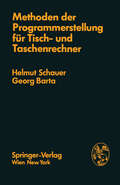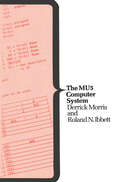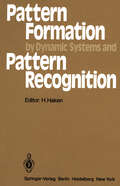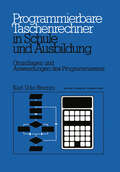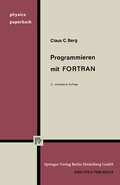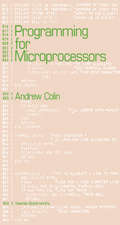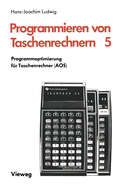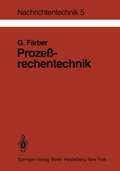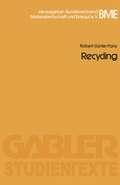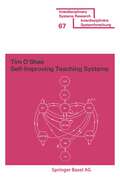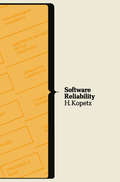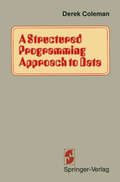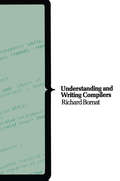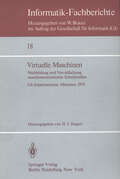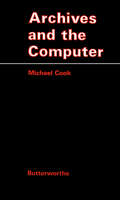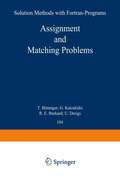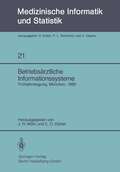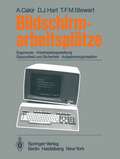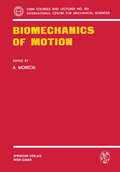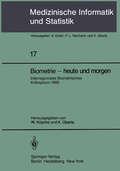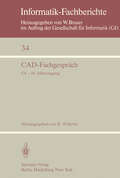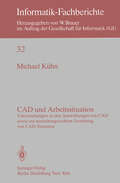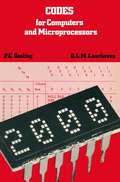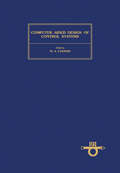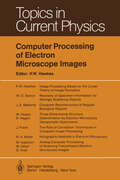- Table View
- List View
Methoden der Programmerstellung für Tisch- und Taschenrechner: Grundlagen, Anwendungen, Grenzen
by H. Schauer G. BartaPattern Formation by Dynamic Systems and Pattern Recognition: Proceedings of the International Symposium on Synergetics at Schloß Elmau, Bavaria, April 30 – May 5, 1979 (Springer Series in Synergetics #5)
by Hermann HakenThis book contains the manuscripts of the papers delivered at the International Sym posium on Synergetics held at SchloB Elmau, Bavaria, Germany, from April 30 until May 5, 1979. This conference followed several previous ones (Elmau 1972, Sicily 1974, Elmau 1977). This time the subject of the symposium was "pattern formation by dynam ic systems and pattern recognition". The meeting brought together scientists from such diverse fields as mathematics, physics, chemistry, biology, history as well as experts in the fields of pattern recognition and associative memory. When I started this type of conference in 1972 it appeared to be a daring enter prise. Indeed, we began to explore virgin land of science: the systematic study of cooperative effects in physical systems far from equi~ibrium and in other disciplines. Though these meetings were attended by scientists from quite different disciplines, a basic concept and even a common language were found from the very beginning. The idea that there exist profound analogies in the behaviour of large classes of complex systems, though the systems themselves may be quite different, proved to be most fruitful. I was delighted to see that over the past one or two years quite similar conferences were now held in various places allover the world. The inclusion of prob lems of pattern recognition at the present meeting is a novel feature, however.
Programmierbare Taschenrechner in Schule und Ausbildung: Grundlagen und Anwendungen des Programmierens
by Karl Udo BrommProgrammieren mit FORTRAN (Schriften des Instituts für Gesellschafts- und Wirtschaftswissenschaften der Universität Bonn)
by C. C. BergProgramming for Microprocessors
by Andrew ColinProgramming for Microprocessors deals with the basics of programming for microprocessors and contains practical aids to programming. Topics covered range from assembly language and microprocessor design to the Motorola 6800, programming techniques, control of peripheral devices, and high-level languages. Emphasis is given to the computer-like aspects of microprocessors. This text is comprised of 12 chapters; the first of which provides a general overview of microprocessors, differences between hardwired and programmed devices, and different kinds of microprocessors. The reader is then introduced to the basic types of information inside a microprocessor, including Boolean information, numerical information, character codes, and the machine code. The chapters that follow focus on the intellectual and practical tools that the designer of a microprocessor system will need. The basic structure of a microprocessor is analyzed, with particular reference to a simple hypothetical computer and some programs for this machine. This book also discusses assembly language; some of the features that give microprocessors their flexibility as well as generality and power; and the Motorola 6800 microprocessor as an example of machine architecture. Some programming techniques, high-level languages for writing programs, and the problem of bringing the hardware and software together are highlighted. This book will be useful to computer programmers, computer scientists, and electronic engineers.
Programmoptimierung für Taschenrechner (Programmieren von Taschenrechnern #5)
by Ludwig Hans-JoachimDer programmierbare Taschenrechner hat inzwischen eine weite Verbreitung gefunden. Nicht nur in die Technik, sondern auch in Forschung und Lehre hat er seinen Einzug gehalten. Dabei erschließen ihm seine vielfältigen Einsatzmöglichkeiten, die hochent wickelte Technologie und der immer günstiger werdende Preis weiterhin ständig neue Anwendungsbereiche und Abnehmerkreise. Der Umgang mit ihm ist denkbar einfach, wie auch der Anfänger sofort erkennen wird. Die inzwischen erschienene einführende Literatur tut ein übriges dazu, schnell mit ihm vertraut zu werden. Doch gehören Erfahrung und Detailkenntnisse dazu, optimale Lösungen zu finden. Das geschickte Ausnutzen des Taschenrechners bis an die Grenzen seiner Möglichkeiten vermag die Leistungsfähigkeit eines Programms erstaunlich zu er höhen. Trainierte Rechnerbenutler können arbeitsfähige Programme nicht nur in sehr kurzer Zeit erstellen, sondern auch für Probleme entwickeln, die mit programmierbaren Taschenrechnern zu lösen man nicht für möglich gehalten hätte. Zweck des Buches ist es, in diesem Sinne gezielte Anleitung zu optimaler Programmierung zu geben. Wir setzen dafür erste Kenntnisse des Lesers in dem Umgang mit seinem Taschenrechner voraus. Die einzelnen Tasten sollten ihm bekannt sein, auch sollte er wissen, wie man ein Programm in den Rechner eingibt und ablaufen läßt. Wir erwarten aber nicht, daß er sich bereits gründlich mit ihm befaßt hat. Die erforderlichen mathematischen Kennt· nisse haben wir mit Absicht so gering gehalten, daß das Buch gleichermaßen von I nge· nieuren, Lehrern und Studenten aller Fachrichtungen nutzbringend gelesen werden kann.
Prozeßrechentechnik: Allgemeines, Hardware und Software, Planungshinweise (Nachrichtentechnik #5)
by G. FärberRecycling (Gabler-Studientexte)
by Robert Günter PanzDas Thema soll in einen Grenzbereich der Materialwirtschaft führen, der durch die tagespolitischen Ereignisse immer größere Bedeutung für die Unternehmung gewinnt. Naturgemäß ist in einer marktorientierten Gesellschaft das verkaufs fähige Produkt da~ Objekt aller Anstrengungen und Leistungen. Produktion und Verkauf stehen im Blickpunkt, andere Bereiche werden als notwendig be trachtet, während das Gebiet der Entsorgung innerhalb der Unternehmung zu nächst ohne besondere Beachtung bleibt. Mit zunehmender technologischer Perfektion, finanzwirtschaftlicher Beherrschung des Produktabsatzes rückt die Güterbereitstellung zur Deckung des Bedarfs plötzlich in den Hintergrund - Schlagworte wie Konsumterror, Abfallgesell schaft u. ä. kennzeichnen den Wandel - und die Frage nach der Qualität der Produktion, nicht mehr des Produkts, gewinnt eine neue Dimension. Damit wird für die Unternehmung die Alternative aufgezeigt, daß es nicht so sehr auf die Qualität des Produktes ankommt, weil die Grundbedürfnisse befriedigt sind, sondern auf die Qualität der Produktion, damit die Beeinträchtigung kleiner bleibe als der Nutzen der Bedarfsbefriedigung. Diese Überlegungen zwingen die Unternehmung, einen Sektor ihrer Existenz sowohl in die Kosten- als auch in die Erlösbetrachtung einzubeziehen, nämlich den Umweltschutz mit seinen Be reichen Luft- und Wasserbelastung, Abfallbeseitigung sowie Rückgewinnung von Kreislaufstoffen aus der Luft, dem Wasser und den Abfällen. Eine Materialverwertung ohne Reststoffe mit einem Produktionsverfahren ohne Umweltbeeinträchtigung wird in der Zukunft keine Standortprobleme, keine negative Publizität kennen und im Markt dadurch begünstigt sein.
Self-Improving Teaching Systems: An Application of Artificial Intelligence to Computer Assisted Instruction (Interdisciplinary Systems Research)
by O'SHEAA Structured Programming Approach to Data
by COLEMANMuch of current programming practice is basically empirical and ad hoc in approach. Each problem is tackled without relation to those that have gone before; experiences are made and stored as a series of fragments. Now, under the pressure of events, this unsatisfactory state of affairs is coming to an end. Programming is becoming a technology, a theory known as structured programming is developing. The purpose of a theory is to categorise and explain existing practice, thus enabling it to be improved through the development of new and sharper techniques. The resulting experiences have then to be fed back into the theory so that the process of enrichment may continue. This dialectical relationship between theory and practice is essential to a healthy programming technology. The lack of such a relationship in the 1950s and 60s and the accompanying software crisis certainly confirm the converse of this proposition. My aim in writing this book has been to explain the current state of the theory of structured programming, so that it may be used to improve the reader's practice. The book deals with two facets of programming - how to design a program in terms of abstract data structures and how to represent the data structures on real and bounded computers. The separation between program design and data structure representation leads to more reliable and flexible programs.
Virtuelle Maschinen: Nachbildung und Vervielfachung maschinenorientierter Schnittstellen. GI-Arbeitsseminar, München 1979 (Informatik-Fachberichte #18)
by H. J. SiegertArchives and the Computer
by Michael J. CookArchives and the Computer deals with the use of the computer and its systems and programs in archiving data and other related materials. The book covers topics such as the scope of automated systems in archives; systems for records management, archival description, and retrieval; and machine-readable archives. The book also features examples of systems for records management from different institutions such as theTyne and Wear Archive Department, Dyfed Record Office, and the University of Liverpool. Included in the last part are appendices. Appendix A is a directory of archival systems, Appendix B contains guidelines for machine-readable and related records for preservation, and Appendix C covers machine-readable archives. The text is recommended for archivists who would like to know more about the use of computers in archiving of records and other related information.
Assignment and Matching Problems: Solution Methods with FORTRAN-Programs (Lecture Notes in Economics and Mathematical Systems #184)
by R. E. Burkard U. DerigsBetriebsärztliche Informationssysteme: Frühjahrstagung der GMDS, München, 21. – 22. März 1980 (Medizinische Informatik, Biometrie und Epidemiologie #21)
by J. R. Möhr C. O. KöhlerBildschirmarbeitsplätze: Ergonomie Arbeitsplatzgestaltung Gesundheit und Sicherheit Aufgabenorganisation
by A. Cakir D. J. Hart T. F. StewartBiometrie — heute und morgen: Interregionales Biometrisches Kolloquium 1980 der Deutschen Region und Region Österreich — Schweiz der Internationalen Biometrischen Gesellschaft München, 17.–20. März 1980 (Medizinische Informatik, Biometrie und Epidemiologie #17)
by W. Köpcke K. ÜberlaCAD-Fachgespräch: GI — 10. Jahrestagung, Saarbrücken, 30. September – 2. Oktober 1980 (Informatik-Fachberichte #34)
by R. WilhelmCAD und Arbeitssituation: Untersuchungen zu den Auswirkungen von CAD sowie zur menschengerechten Gestaltung von CAD-Systemen (Informatik-Fachberichte #32)
by M. KühnComputer Aided Design of Control Systems: Proceedings of the IFAC Symposium, Zürich, Switzerland, 29-31 August 1979
by M. A. CuenodComputer Aided Design of Control Systems focuses on the use of computers to analyze and design the control of various processes, as well as the development of program packages with different algorithms for digital computers. The selection first takes a look at the computer aided design of minimal order controllers, including design of interacting and noninteracting dynamic controllers of minimal order and basic algorithm. The book then discusses an accelerated Newton process to solve Riccati equation through matrix sign function; suboptimal direct digital control of a trickle-bed absorption column; and structural design of large systems employing a geometric approach. The text underscores the computer as an aid for the implementation of advanced control algorithms on physical processes and analysis of direct control algorithms and their parallel realization. Topics include hardware influences on the control, process influence, and interactive structure design of direct control systems. The book also takes a look at the optimal control of randomly sampled linear stochastic systems; computer aided design of suboptimal test signals for system identification; and computer aided design of multi-level systems with prescribed structure and control constraints. The selection is a dependable source of data for readers interested in the uses of computers.
Computer Processing of Electron Microscope Images (Topics in Current Physics #13)
by J. Frank P. W. Hawkes R. Hegerl W. Hoppe M. S. Isaacson D. Kopf J. E. Mellema W. O. Saxton M. Utlaut R. H. WadeTowards the end of the 1960s, a number of quite different circumstances combined to launch a period of intense activity in the digital processing of electron micro graphs. First, many years of work on correcting the resolution-limiting aberrations of electron microscope objectives had shown that these optical impediments to very high resolution could indeed be overcome, but only at the cost of immense exper imental difficulty; thanks largely to the theoretical work of K. -J. Hanszen and his colleagues and to the experimental work of F. Thon, the notions of transfer func tions were beginning to supplant or complement the concepts of geometrical optics in electron optical thinking; and finally, large fast computers, capable of manipu lating big image matrices in a reasonable time, were widely accessible. Thus the idea that recorded electron microscope images could be improved in some way or rendered more informative by subsequent computer processing gradually gained ground. At first, most effort was concentrated on three-dimensional reconstruction, particu larly of specimens with natural symmetry that could be exploited, and on linear operations on weakly scattering specimens (Chap. l). In 1973, however, R. W. Gerchberg and W. O. Saxton described an iterative algorithm that in principle yielded the phase and amplitude of the electron wave emerging from a strongly scattering speci men.
